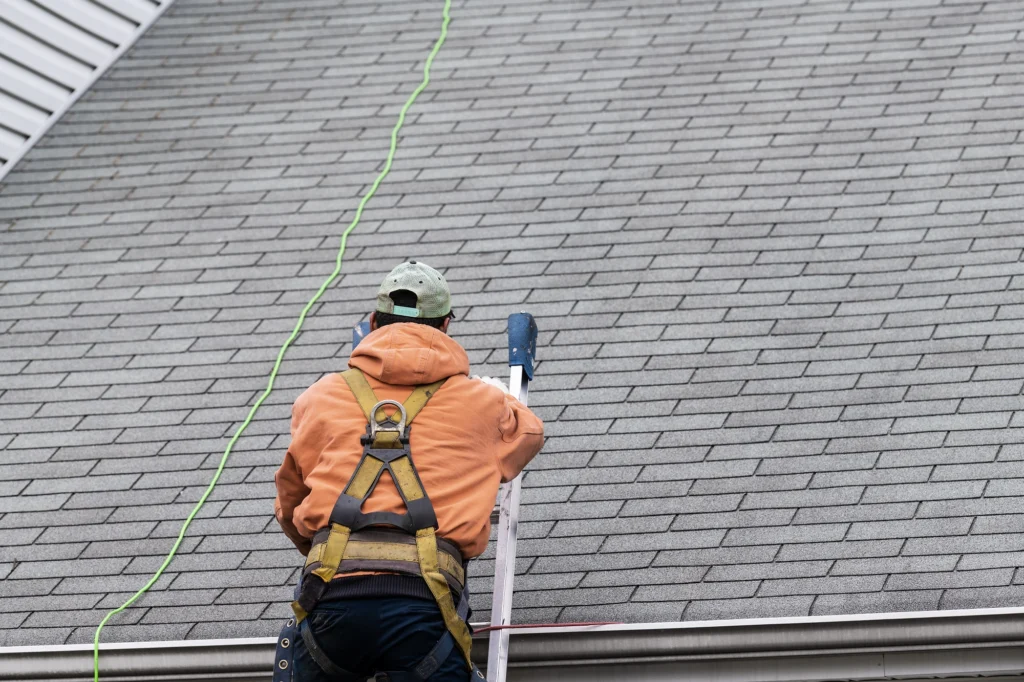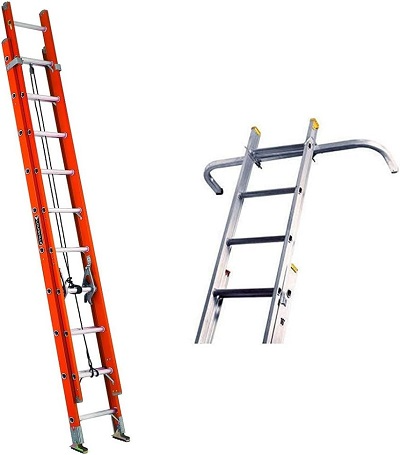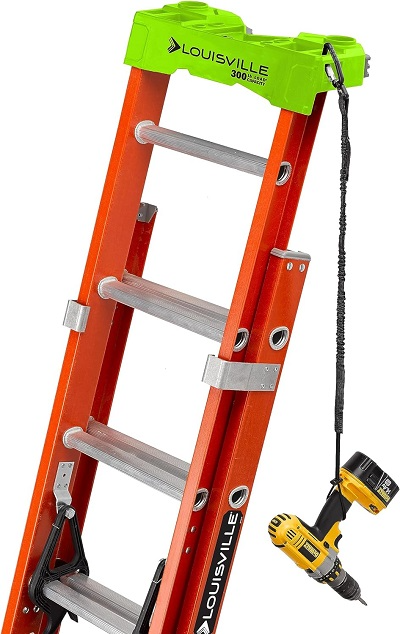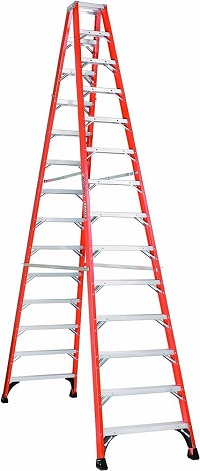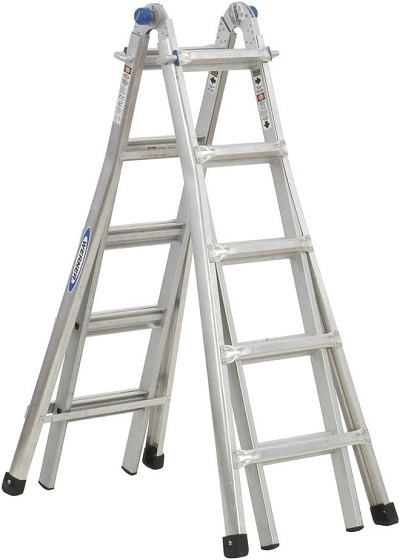According to the Occupational Safety and Health Administration (OSHA), roofing is one of the most dangerous jobs, with a fatal work injury rate of 57.5 per 100,000 full-time equivalent workers. That’s why choosing the best roofing ladder is crucial—not only for your family’s and our team’s safety but also to ensure we can perform quality roofing work and get your roofing project done efficiently.
Here we’ll explain what criteria we look for when selecting a roofing ladder, as well as the different kinds of ladders used for roofing (and other tasks). Finally, we’ll share 5 of our favorite roofing ladders that have proven sturdy and reliable on our roofing jobs.
Our go-to roofing ladder is the Type IA duty-rated Louisville Ladder FE3232 Fiberglass Extension Ladder that comes with the LP-2200-00 Stabilizer. It extends to a maximum of 29 feet, and the stabilizer holds the ladder 12 inches from the wall and has a span of 48 inches, so it’s great when we need extra stability or need to work around obstacles like windows. Heavy-duty safety shoes with thick rubber treads that won’t mark surfaces, fully serrated D-shaped rungs, heavy-duty slide guides to prevent overextension, and Louisville Ladder’s custom-engineered MAXLOCK™ rung locks make this ladder rugged and stable.
In this article:
- Types of Roofing Ladders
- What We Look for in the Best Roofing Ladders
- The Best Roofing Ladders for 2024
- Frequently Asked Questions
Types of Roofing Ladders
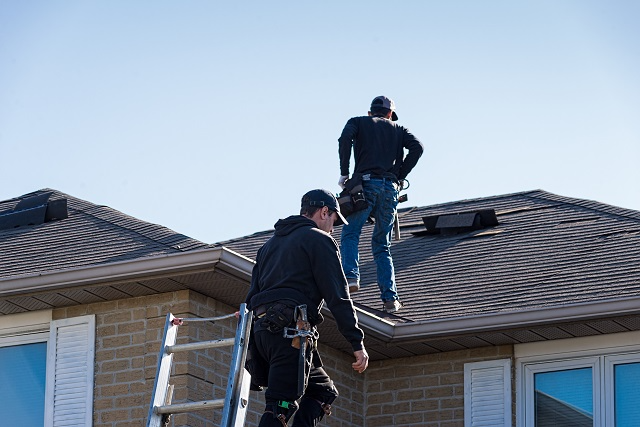
Roofers may use a combination of different types of ladders to get the job done, depending on the task at hand and the roof’s slope and construction. Here’s a look at some of the most common types of roofing ladders used for roofing replacement and repairs.
Extension Ladders
Extension ladders are commonly used for roofing work. They have sliding sections that allow them to be extended to different lengths, so we can use them for reaching roofs of different heights.
Extension ladders are typically made of aluminum or fiberglass, giving them the durability and ruggedness roofing requires. These materials are also lightweight, allowing our team to easily move the ladder from place to place while we work.
Hook Ladders (Roof Ladders)
Hook ladders are also known as roof ladders, as they’re designed specifically for roofing work. Essentially, these ladders are extension ladders that have hooks at the top that anchor to the roof’s ridge, which gives them stability when working on steep slopes.
The hooks prevent the ladder from sliding, which allows our team to work safely (and get your roofing job done quickly).
Telescoping Ladders
Telescoping ladders are similar to extension ladders in that they can be extended, but rather than having different sections that overlap, they collapse into themselves like a telescope.
They’re compact and easily portable, but they tend to have a lower weight capacity compared to extension ladders. Stability can also be a problem with telescoping ladders, so for roofing jobs, extension ladders and hook ladders are often a better choice.
Step Ladders
Step ladders have a self-supporting A-frame design with steps on both sides, making them useful for roofing tasks that require both hands. They are typically made of aluminum, fiberglass, or wood.
Platform Ladders
Similar to step ladders, platform ladders have an A-frame design with steps on both sides. The difference is that platform ladders have a larger platform at the top, which gives the ladder more stability and also provides valuable space for our roofing tools and materials.
They’re useful for tasks that require spending a lot of time on a ladder, making them ideal for roofing installation and repairs.
Combination Ladders
These versatile ladders, known as combination roofing ladders or multi-position ladders, can be adjusted to different configurations, such as A-frame, extension, or scaffolding (more on scaffolding ladders below). Typically made of aluminum or fiberglass, they’re ideal for roofing work that requires working at different heights and angles.
Articulated Ladders
Articulated ladders are similar to combination ladders in that they can be set up in multiple configurations. These ladders can be set up as single or extension ladders (both with and without a stand-off), stepladders, scaffolding ladders, trestle ladders (more on trestle ladders below), or work tables.
The key characteristic of articulated ladders is that they have multiple pairs of articulated joints that can be locked in multiple positions, so they can be set up at the proper angle depending on the configuration.
Scaffolding Ladders
Scaffolding ladders are designed to provide a stable and secure platform for working on roofs. With a wide base and adjustable height, they can be used as a scaffolding system for larger roofing projects. They’re typically made of aluminum or steel for strength and stability.
Trestle Ladders
Trestle ladders, also known as double-front ladders, are self-supporting, and they’re generally not adjustable in length. With a hinge at the top, these ladders have two surfaces and can support two people at the same time.
One important thing to note about trestle ladders is that they can only be used on surfaces that provide level ground support for all four side rails.
What We Look for in the Best Roofing Ladders

When we’re selecting a roofing ladder, there are a few key features we look for to ensure we’re choosing the best ladder for safety, effectiveness, and ease of use.
- Ladder type: As we discussed above, there are different types of ladders that may be used in roofing. Each type of ladder is ideal for different roofing tasks, so one of our first considerations is to select a ladder that’s suitable for the type of roofing work we’ll be doing.
- Ladder size: Extension ladders must extend at least 3 feet beyond the top support point, and their sections must overlap by 3 feet or more (for ladders up to 36 feet) and up to 5 feet for longer ladders. It’s also important to consider the angle. For every 4 feet of ladder height, the ladder base must rest 1 foot away from the surface it rests against. All things considered, extension ladders should typically be 7 to 10 feet longer than the highest resting point on the roof.
- Material: Materials like fiberglass and aluminum are both lightweight and durable. Aluminum ladders, in particular, are lighter and easier to move around. Fiberglass doesn’t conduct electricity, so fiberglass roofing ladders are ideal for projects that require us to work near electrical hazards.
- Portability: While the material impacts the weight of the ladder, it’s also important to consider its portability, especially if we’ll be moving it frequently. Telescoping ladders, for example, can be easily transported and set up quickly, so they’re ideal for moving between multiple job sites.
- Non-slip feet: Non-slip feet are crucial when selecting a roofing ladder. They allow the ladder to maintain stability on potentially uneven surfaces.
- Stabilizers or standoffs: Stabilizers or standoffs increase a ladder’s footprint, improving stability. Another benefit of standoffs or stabilizers is that they won’t damage your gutters or siding. Some of the best roofing ladders come with stabilizers, but you can also purchase them separately (like this one from Louisville Ladder or this model from Roof Zone) for a ladder you already have.
- Extra-wide or D rungs with slip resistance: Extra-wide rungs can provide more stability for climbing and standing. Likewise, D rungs have a flat surface that’s at just the right angle for safe and comfortable footing. Also, look for slip-resistant rungs in a roofing ladder to ensure safety.
- Weight capacity: The weight capacity, or duty rating, of a ladder is one of the most important considerations. We look for ladders that can accommodate the weight of our workers as well as any materials and equipment they’ll need. Below is a chart that includes the five duty ratings and their associated weight capacities:
| Duty Rating | Weight Capacity |
|---|---|
| Type III (Light Duty) | 200 pounds |
| Type II (Medium Duty) | 225 pounds |
| Type I (Heavy Duty) | 250 pounds |
| Type IA (Extra Heavy Duty) | 300 pounds |
| Type IAA (Extra Heavy Duty) | 375 pounds |
For roofing work, only ladders rated Type I, Type IA, and Type IAA are suitable for use. Choose a ladder with a sufficient duty rating to ensure safety.
The Best Roofing Ladders for 2024
Here are a few of our favorite roofing ladders that we’ve used on the job. We’ve included various types of ladders below, so keep in mind that choosing the proper ladder type for the task is crucial for safety and efficiency.
Best Ladder/Stabilizer Combo: Louisville Ladder FE3232 Fiberglass Extension Ladder
The Louisville Ladder FE3232 is a 32-foot fiberglass extension ladder that comes with Louisville Ladder’s LP-2200-00 Stabilizer. It extends to a maximum of 29 feet and has a duty rating of Type IA, meaning it can hold a maximum weight of 300 pounds.
The ladder itself weighs 70 pounds, and the stabilizer adds less than 5 pounds to the total weight. Still, moving it around often requires two people.
This ladder has heavy-duty plated steel swivel safety shoes with thick rubber treads for stability and mar-resistant rail end caps to protect the surfaces we work on.
Other safety features include D-shaped rungs that are fully serrated, providing a secure, slip-resistant surface. The Louisville Ladder FE3232 also has extra heavy-duty slide guides at the top of the base section and a stop on the fly section, ensuring that it can’t be overextended. It also features Louisville Ladder’s MAXLOCK™, an ultra-strong yet lightweight rung lock, and a pulley system for smooth and easy height adjustments.
The stabilizer attachment can be used on extension and single ladders with rails up to 4 inches by 1.75 inches. It holds the ladder 12 inches from the wall, and thanks to its 48-inch width, we can use it to work around most windows and other obstacles. The stabilizer easily attaches to the ladder with two U-bolts and comes with extra replaceable heavy-duty rubber tips to protect surfaces.
Best Extension Ladder: Louisville Ladder L-3022-32PT Fiberglass Extension Ladder with ProTop
The 32-foot Louisville Ladder Fiberglass Extension Ladder has a Type IA duty rating, so it can safely accommodate up to 300 pounds. It has a maximum standing height of 25 feet and a maximum reach of about 31.5 feet (379 inches), and at 67 pounds, it’s easy to move from place to place as our team works on your roofing project.
This extension roofing ladder features a ProTop, which has a V-shaped front corner grip that gives it greater stability on corners and a wider design that provides 100% more contact on flat surfaces. It feels remarkably safe and secure, even when standing at the highest point when the ladder is fully extended.
The ProTop also features a pole grip, integrated bumper, and work tray with multiple storage compartments to store tools and supplies, such as a roofing nailer, tape measure, nails, clips, and brackets. It even has a magnet to keep loose nails and screws in place. With the essentials easily accessible, our roofers don’t have to make as many trips up and down the ladder, which helps us complete your roofing job more efficiently.
Like the Louisville Ladder FE3232 above, this extension ladder has fully serrated, 1.5-inch D-shaped rungs to provide a slip-resistant surface and non-marring rail end caps to protect surfaces. While we typically prefer deeper rungs, the design on this ladder gives them a secure feel despite their narrow width.
It’s also equipped with the QuickLatch MAXLOCK™ rung lock, outside slide guides to prevent overextension, a rope and pulley, and a heavy-duty metal boot with steel swivel safety shoes that can be used either with the tread down or in a spiked position.
Best Combination Ladder: Little Giant Ladder Systems M26
When we’re not sure what type of ladder a job will require, the Little Giant Ladder Systems M26 is a versatile ladder that proves useful for a variety of roofing tasks. This 26-foot multi-position ladder is made of aluminum and has a Type IA duty rating, so it can accommodate up to 300 pounds.
With its Rock Lock adjusters, this ladder can easily be configured as an A-frame, extension ladder, trestle-and-plank, 90-degree, or staircase ladder. It features wide-flared ratchet leg levelers that can be adjusted up to 7 inches to provide greater stability on uneven surfaces.
While it weighs 54.5 pounds, it’s also equipped with tip-and-glide wheels for easy portability, although the wheels don’t always roll smoothly across rough or uneven terrain. While we do wish the 1.5-inch rungs were a bit deeper, this ladder has a solid, sturdy feel overall.
You can purchase this ladder in various bundles, each with a different accessory for even more versatility. You can buy it with a:
- Cargo hold: A sturdy tool pouch made of ballistic nylon and steel
- Project tray: A storage tray to keep our tools handy with a magnetic dish to hold lose loose nails and screws
- Storage rack: Heavy-duty, high-strength polymer rack securely stores the ladder so it’s easily and safely accessible when we need it
- Trestle bracket: For converting the ladder into scaffolding with a plank (sold separately)
- Wall standoff: Allows us to work around obstacles like windows or gutters
- Work platform: A flat surface that can be used as a comfortable standing platform or tool tray
Note that some of these bundles do not include leg levelers, so be sure to read the product details carefully to get the features you need.
Best Trestle Ladder: Louisville Ladder FM1414HD Twin Front Stepladder
The 14-foot Louisville Ladder FM1414HD Twin Front Stepladder has a Type IAA duty rating, meaning it can accommodate up to 375 pounds on each side simultaneously. It has 3-inch rungs that are spaced 12 inches apart on both sides. The rungs are firm, giving the ladder a secure feel as you climb.
Like the other Louisville Ladders on our list, this model has heavy-duty, impact-resistant, and slip-resistant shoes with rugged, non-marring tread, providing the stability our roofers need to stay safe while also protecting surfaces.
This fiberglass twin-front stepladder features inside spreader braces that enhance safety and stability during use while also protecting it from damage when we’re transporting it from job site to job site. In addition, it’s equipped with Louisville Ladder’s SHOX impact absorption system, heavy-gauge steel hinges, heavy-duty gusset bracing, and riveted step construction.
The roofing ladder’s base spread is 9 feet, 5.4 inches, and its maximum reach height is 14 feet. It weighs about 80 pounds, so it’s not ideal for jobs that require frequent moving. However, it is a valuable tool for tasks that require an extra set of hands, and it feels sturdy and stable at all heights.
Best Telescoping Ladder: Werner MT-22 Telescoping Ladder
The Werner MT-22 Telescoping Ladder extends to 22 feet and is constructed of lightweight aluminum. While many telescoping roofing ladders have lower weight capacities compared to extension ladders, this powerful little tool can accommodate up to 300 pounds.
It’s also versatile, with 28 different height and position adjustments. The push-knob locking hinges on the sides of the ladder allow it to be configured as a twin stepladder, extension ladder, or scaffold. We can easily disengage the spring-loaded J-locks on either side of the ladder to adjust the height—in 1-foot increments—for different areas of a roof and then simply re-engage them to secure it at the desired height. There’s no rope for adjusting the height, though, so it’s easy to pinch your fingers if you’re not careful.
The Werner MT-22’s double-riveted steps, extra-wide flared bottom, and heavy-duty non-marring feet provide slip resistance for enhanced safety. In the twin stepladder configuration, it can support up to 300 pounds on both sides.
As an extension ladder, the Werner MT-22 can extend from 11 to 19 feet, and as a stepladder, it can be adjusted from 5 to 9 feet. At 42 pounds, it’s lightweight for easy portability while having a sturdy, rugged feel. That said, it can be a bit challenging to maneuver for one person when fully extended, but this is rarely an issue for us as we have multiple workers at a job site.
Frequently Asked Questions
What size ladders do roofers use?
We typically use 24- to 32-foot extension roofing ladders. The choice of ladder size depends on the height of the roof and the specific tasks to be performed.
Are ladder roof hooks safe?
Yes, ladder roof hooks are safe when used correctly. They’re designed to secure the top of a ladder to the roof, providing stability and preventing slippage. It’s essential to follow the manufacturer’s instructions for proper setup and use.
How high should a ladder be above the roof?
A ladder should extend at least 3 feet above the roof’s edge. This provides a safe and stable area to hold onto when we’re transitioning from the ladder to the roof and back.
How do you secure a ladder on a sloped roof?
To secure a ladder on a sloped roof, use ladder hooks or a stabilizer bar that attaches to the ladder and rests against the roof. Ensure that the ladder’s base is on solid, level ground, and use additional safety equipment like non-slip mats or anchors if necessary.
What is the 4-to-1 ladder rule?
According to the 4-to-1 rule, the ladder base should be placed one foot away from the structure it leans against for every four feet of ladder height. This ratio helps ensure the ladder’s stability and safety by providing the optimal angle for safe climbing.

